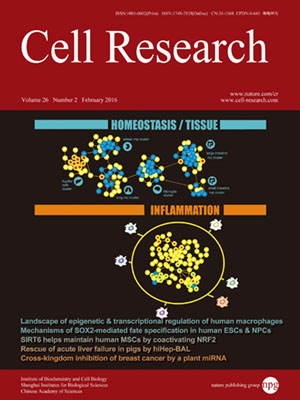
Volume 26, No 2, Feb 2016
ISSN: 1001-0602
EISSN: 1748-7838 2018
impact factor 17.848*
(Clarivate Analytics, 2019)
Volume 26 Issue 2, February 2016: 254-257 | Open Access
LETTERS TO THE EDITOR
Casilio: a versatile CRISPR-Cas9-Pumilio hybrid for gene regulation and genomic labeling
Albert W Cheng1,2,3,*, Nathaniel Jillette1,2,*, Phoebe Lee1, Dylan Plaskon1, Yasuhiro Fujiwara1, Wenbo Wang1, Aziz Taghbalout2 and Haoyi Wang1,4
1The Jackson Laboratory, Bar Harbor, ME 04609, USA
2The Jackson Laboratory for Genomic Medicine, Farmington, CT 06032, USA
3Department of Genetics and Genome Sciences, University of Connecticut School of Medicine, Farmington, CT 06030, USA
4State Key Laboratory of Stem Cell and Reproductive Biology, Institute of Zoology, Chinese Academy of Sciences, Beijing 100101, China
Correspondence: Haoyi Wang, E-mail: wanghaoyi@ioz.ac.cn; Albert W Cheng,(albert.cheng@jax.org)
The CRISPR-Cas9 system has recently been widely adopted in genome editing due to its simplicity1,2,3. Nuclease-deficient mutant dCas9 protein can be fused to effector domains and the fusion proteins can be guided by sgRNAs to genomic sites to regulate gene expression or label chromosomes4,5,6,7,8,9,10. However, only one type of effector is applied in most experiments due to the exclusive sgRNA:Cas9 pairing. Moreover, multimerization by directly fusing multiple copies of effectors with dCas9 protein to achieve sufficient effector activity is technically challenging. RNA aptamer approaches utilizing viral RNA sequences such as MS2 and PP7 have been combined with the CRISPR-Cas9 system to provide tools with improved multiplexing and multimerization functionalities11,12.
10.1038/cr.2016.3
FULL TEXT | PDF
Browse 1937


